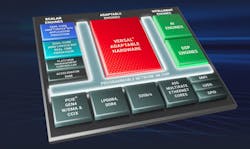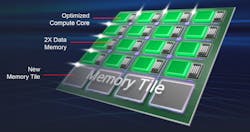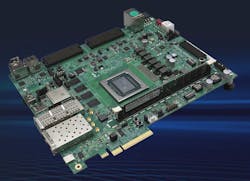Xilinx’s Adaptive Compute Acceleration Platform (ACAP) has been around for a number of years. The company filled out the mid-range Versal Prime and high-end Versal Premium computing solutions first. The new Versal AI Edge, however, targets the low end of the spectrum where efficient artificial-intelligence (AI) and machine-learning (ML) applications can be quite valuable. Xilinx isn’t alone in attacking this space, but the combination of AI/ML acceleration, FPGA configurability, a high-speed fabric, and an Arm-based compute cluster provides significant benefits in rapid time-to-market as well as hardware and software configurability.
The Versal AI Edge series uses the architecture like the rest of the Versal family. A programmable-network-on-chip connects major components such as the adaptable hardware, which is Xilinx’s flagship FPGA fabric (Fig. 1). The other components, including communication and the AI engines, are tailored to edge computing that has different AI/ML needs than other markets like cloud computing.
The AI Engine for the Versal AI Edge series uses more compact numeric formats like INT4 and BFLOAT16 (Fig. 2). This makes it possible to build ML models that provide accuracy comparable to implementations using larger values. It’s a common approach to AI accelerators that target edge applications where trained models are often identifying images or trends.
The series also doubles the amount of data memory to 64 kB and adds a new memory tile to the designs with up to 32 MB of additional high bandwidth memory. Overall, the system is designed to deliver 4X the ML compute power with half the latency compared to other platforms, e.g., GPU-base solutions. Of course, your mileage may vary.
The Versal AI Edge series targets a range of applications, including demanding areas such as automotive advanced driver-assistance systems (ADAS) and automated driving. It also incorporates Ethernet and CAN FD support. ML models can be used to analyze radar, LiDAR, and camera streams in real-time. The series meets standards such as ISO 26262, IEC 61508/62061/13849/61511, EN 60601 (medical), and DO-254/178. All chips are suitable for rugged applications where size, weight, and power (SWaP) are important while staying within a designated thermal envelope.
The Versal AI Edge series features lots of software support, including the Xilinx Vitis software platform and the Vivado Design Suite. Xilinx also has a number of application-oriented stacks (Fig. 3).
Developers can get started by using the Versal AI Core ACAP VCK190 Evaluation Kit (Fig. 4). Software tools will be available at the end of 2021, while the hardware and kit is expected to arrive in the second half of 2022.





